Design Is NOT Branding: 10 Things Every Business Owner and Entrepreneur Should Know
Everyone knows that you mustn’t judge a book by its cover. Yet, the number one misunderstanding on what branding is all about typically comes from small and medium-sized businesses who often don’t understand the difference between design and branding because they don’t have access to big-brand ‘know-how’.
- Don’t confuse branding strategy with asking a designer for a new logo
- Don’t ask for a website or product packaging first, because that’s not how to build the foundations of a solid standout brand
- Without brand strategy and brand codification to provide the foundation on which the brand is built, the pretty stuff is frequently a guaranteed waste of money
It’s understandable. People can get confused about what’s branding, what’s brand identity, what’s design, and how they’re all connected.
Simply stated, your logo and packaging is part of your brand design and your brand design is part of your brand identity, but your design is not your brand, merely its visual signpost. It’s kind of like: Located at the gateway to New York City, the Statue of Liberty is an iconic symbol of America, but America is not just New York City.

Image via Public Domain Pictures
Just as Lady Liberty lights the way, your brand identity design is a signpost that must clearly point the “way” for customers. Don’t let them get lost.

Image via Pixabay
Branding vs. Designing: First Things First
Let’s talk. It’s no good buying lovely china teacups for a party when you haven’t got a table to place them on…or anybody to invite to the party.
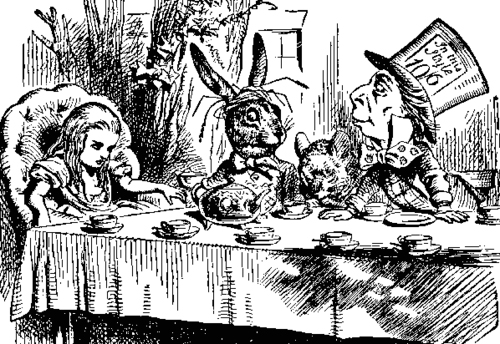
Image via Wikimedia Commons
“Through the Looking-Glass”: The first “Unbirthday Party” had it all.
In 1871, Lewis Carroll didn’t draw the picture before he wrote the book.
Getting the teacups doesn’t get you a party and creative design solutions doesn’t create a brand.
The branding process provides the direction for the brand design outputs and communications process that follows on from it.
Brand Building Foundations and StrategyBEFORE Design, Communications or Marketing Activities | |
FirstA brand must evaluate, identify, codify, map out and articulate what it stands for – to become highly visible, command a premium and give its customers a compelling reason to buy. The elements listed below are the GPS or roadmap for every brand because the outputs provide the direction for communications, design and marketing activities. | SecondDesign, visual content, text, sales scripts, campaigns and marketing activities are created to communicate the brand’s offering and attract its ideal customers to close the sale. The visual language expressing the brand in meaningful context can only be created once the factors that make it different, distinctive, memorable and likeable have been identified, codified and developed in stage one as listed. |
Website/Social Platforms | |
Copywriting Style and Language | |
Content | |
Graphic Elements | |
Signature Language / Voice | Photography / Illustration |
Video / Music | |
Advertising | |
Customer Journey and Experience | Brand Sales Scripts |
What is Branding?
Branding involves a wide range of fundamental concepts. Most importantly, your brand is the cornerstone and foundation that your business is built upon.
- It defines who you are
- It defines what you stand for
- It informs why you exist
- It explains how you’re different
What is Brand Design?
Brand identity design is the outward expression of an organization, product or service that includes its name, logo, and overall visual appearance.
- It is the fundamental means of customer recognition
- It is the first thing that your customer identifies with your company
- It symbolizes the brand’s differentiation from your competitors
- It communicates your uniqueness quickly and effectively
— Test Yourself:
What brands are represented here by designs that have done their job so well that actual brand names aren’t even necessary?
- How do these brands make you feel?
- What do you associate with these brands?
- What do you think about these brands compared to their competitors?

Image via Selfridges
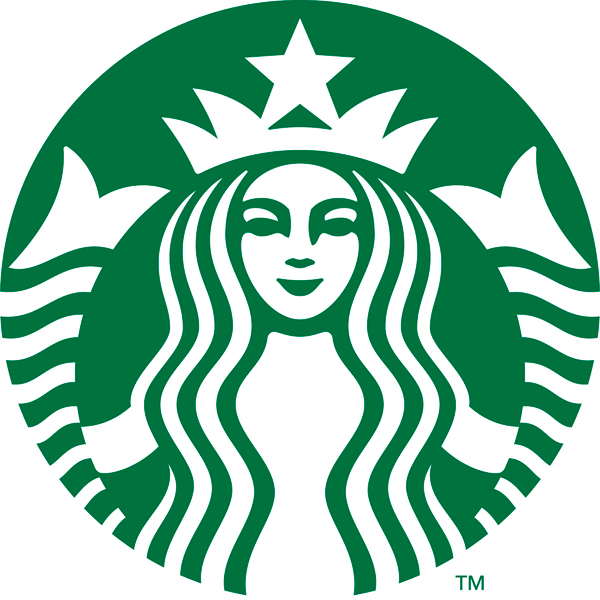
Image via Starbucks
Undressed: Strength of Branding
Looking at the green mermaid you can just smell the coffee brewing.
These pieces of packaging are just the visual identity of something much bigger. It’s really about the brand and what it stands for because even without wearing their logos these undressed brands evoke powerful feelings in us.
We perceive them fully in terms of the customer experience and their value due to price points and positioning versus their competitors.
If you’re struggling to develop your branding versus your design so you’re totally empowered to make your brand stand out and attract your ideal customers, feel free to get in touch and ask about our brand-building service. You will have absolute clarity over what makes your brand distinctive, different and memorable because our brand building process will enrich your brand with meaning so you can stand out, attract your perfect audience and build trust amongst your ideal customers. Meantime read on because the top 10 brand building tips below will enable you to develop your brand a lot faster and more effectively.
A Brand Refresh Provides Opportunity
If you’ve unintentionally taken a weak approach from the beginning, or circumstances have caused your brand to go a bit off kilter or underperform, don’t despair. A professional brand audit will identify areas of weakness, strength and potential opportunities for innovation and growth coupled with indicating whether a brand refresh strategy is in order for any number of reasons:
- Re-establish market prominence
- Acknowledge and reflect a major acquisition
- Announce a new technology or invention that changes its mission and vision
- Revitalize the voice and significance of the brand
- Refocus the company around major customer and/or industry trends
- Reflect a strategic move to reach new markets
- Give new life to flagging sales
- Amplify differentiation to stand out more strongly
- Adapt to maintain market relevance and changing trends
- Move beyond a negative event
If you’d like to give your brand a health check yourself then our brand audit health check programme, the Auditing Analysis Accelerator™ is the perfect solution for you. You can find out more here and watch a free preview here of how to give your brand a health check yourself.
Want to find out more?
Alternatively, if you’d like professional input and direction for building your brand and would like to leverage our experience and expertise then send us an email to [email protected] or give us a ring T: +353 1 8322724 (GMT hours 9:00 – 17:00). We’d be very happy to speak with you.
Related: Rebranding: 15 Do’s and Don’ts for Brand Success
Digital Adds a Layer to Branding Design
It’s tricky. According to the publication Co.Design, “It has never been harder to design a good visual identity. Brands live on dozens of platforms, so they have to look as good on a billboard as they do on a phone screen.”[1]
Related: Digital Brand Identity Essentials – How to Build, Resonate, and Grow
Your SME/SMB Business Branding and Design Top 10 Tips Guide
Keep in mind these 10 factors are what every entrepreneur and small business owner should know about branding and design…in that order! Branding first, design second!
- Design and branding are inextricably linked but distinctly different. When you leverage them both together properly, it’s a win-win. Branding provides the direction for design, not the other way round so branding and its strategy come before design is even considered.
To ensure the best return on your brand building investment, map out, codify and build your brand fundamentals first so that when you move to the design process you not only get great design, but standout design that reflects, communicates and expresses your brand appropriately in visual terms, because it’s the combined impact of brand strategy and design that creates a highly visible brand.
Only then does design become a leveraged commercial tool that truly supports your business growth objectives while also achieving a measurable return on investment.
- KISS: “Keep it Simple, Stupid.” If they cannot understand the brand (What’s it for? What problem does it solve for me? What does it stand for and why should I care?), they certainly won’t want to engage.
The KISS mantra has worked its way into every marketing rulebook because our brains act as filters to protect us from too much information. SME/SMB business owners must recognize when Too Much Information (TMI) is overload and bound to backfire by turning customers off. It’s essential to identify what really matters to your customers and then speak to them in their language without being overly complex.
Anyone who has ever entered an Apple store can see their clean, uncluttered, patented design and layout. It’s not possible to wonder what they’re selling. This approach to less is more has earned the brand the world’s number one retail ranking for sales per square inch.[2]
Apple Store at Grand Central Terminal, NYC (Credit: Marco Verch, CC)

A Woolworth’s closing sale (Wikipedia)
Woolworth’s, once a top international retailer, closed its stores in 2009.
In downtown San Francisco, a parking facility reminds us of what not to do with this jumbled up messaging. KISS lost its way…Needs simplifying, right?
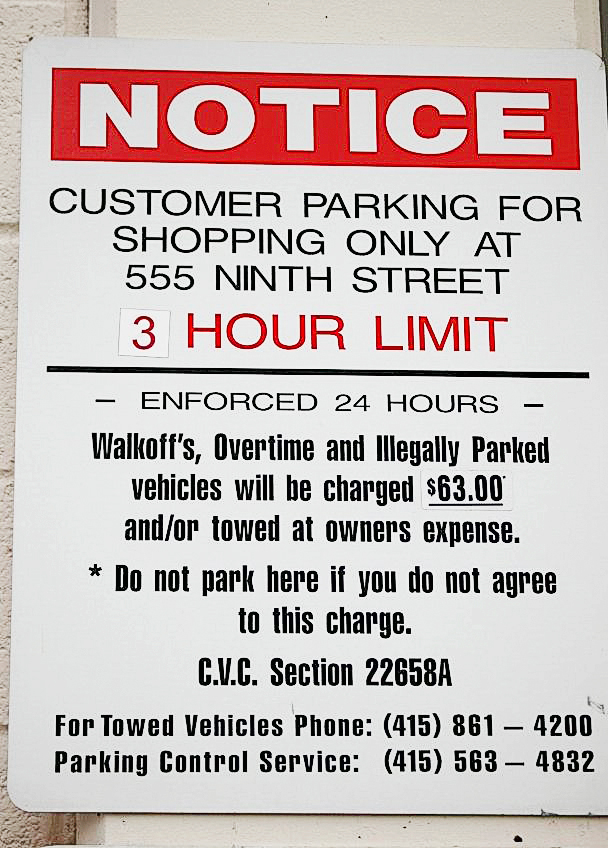
Image via Wikimedia
- Create a strong brand personality. This doesn’t mean creating a cute mascot for every product or service you sell or hiring a VIP or celebrity to be your brand advocate.
Part of brand building is your strategy for connecting with people: customers, yes. But also potential customers, stakeholders, suppliers, and employees alike. What works? Emotion. How to communicate emotion? Through brand personality.
Relatable, engaging, shareable, and often humorous are often interpreted via a persona, an ambassador, a celebrity endorser, a mascot, or an influencer.
Breathe life into your brand. Like people, strong successful brands are alive; they have a distinct voice, individualistic traits, characteristics, and personalities.
Related: Personality Matters: Bringing Your Brand to Life to Grow Profits
Charlie the Tuna was one of the first brand characters (he talked!) created for television in 1958. The dapper, yet cheeky, fish propelled StarKist tuna with a tagline, “Sorry Charlie®” that made its way into the national lexicon. Why? Because “StarKist®doesn’t want tuna with good taste, but tuna that tastes good!”
Along with icons that have endured for decades: the Jolly Green Giant, Morris the Cat, and Ronald McDonald, Charlie made it into the “Salute to Advertising’s Greatest Icons” exhibition at the Museum of Broadcasting in Chicago. See Charlie’s timeline here.
Let the Persona Brand Building Blueprint™ Mastermind be your guide. It’s a highly interactive fast-track programme where you work intensively on your brand alongside other senior managers over the course of two days to codify it, map it out, and build your brand strategy to take your business further, faster. One of the key outcomes is it provides the direction for all your design, marketing and communications campaigns. Discover more about the mastermind here.
- Differentiate to Stand Out. Brands must address positioning in the marketplace as a foundational aspect by identifying their differentiation and unique selling points. Among these are:
- Price
- Expertise
- Distribution
- Purpose
- Heritage
- Innovation
- Storyline
- Convenience
- Delivery
- Quality
- Limited edition
- Personalization
- Customer experience
Related: Brand Differentiation, 30 Ways to Differentiate Your Brand
How one or more of these strategic differentiators translates via design identity is critical to getting the message across to your ideal primary customer so you can attract them to your brand and give them a compelling reason to buy.
- Tell Your Story. Behind every great brand, there’s a great story...or two.
Are you sharing yours? Can you clearly articulate not only what your brand stands for, but also where it came from and how it got to where it is today? What’s your brand’s big “why” and how are you telling that story?
What gets you out of bed in the morning? What’s your inspiration, what’s your vision? How are you translating your unique story and message into something your ideal customer finds irresistible?
Ikea History: How It All Began
Many of the world’s top brands were started by ordinary people with extraordinary ideas and big visions. And being small is a story in itself!
Related: Brand Stories: 5 Compelling Examples That Sell Themselves
- Use Emotion, Use Humour. Quick! Name your favourite commercial of all time. According to consumer research, chances are 71 percent that “funny” is the primary reason you remember the product that advertisement represents.
Be subtle or be outrageous. Tweak a smile or provoke downright belly laughter. Carefully choose the tone of voice that suits your brand or get professional help to do it right.

Build Your Customer Attracting Brand Using The Personality Profile Performer™ Programme with Lorraine Carter
Related: Use Humour in Branding to Create Strong Emotional Bonds to Increase Sales
- Know Your Audience. This is the same advice you’d give to anyone about to make a speech, perform well in an interview, or host a meeting. It’s essential for a brand to know who they’re talking to and where to find them. After all, it’s no good having a great looking resume if you’re applying for a job that’s been filled or designing an amazing slide presentation if the event is held outdoors.
To build your brand effectively you must understand your customers intimately, their needs, wants, loves, hates and aspirations so you can build your brand to really meet their needs — and so they are naturally attracted to it because they find it irresistible.
Consequently, designers must accurately interpret the fully codified and mapped out brand by using the direction it provides to create the appropriate visual communications for a look and feel that will appeal to and attract the ideal target customer and stand out strongly from its competitors.
In 2000, they made a romantic fantasy comedy film about understanding your target customer in ‘What Women Want’. Don’t underestimate the importance of this, understanding your audience has profound implications for your brand strategy.

Image via Flickr, Jonathas Scott
After a freak accident, a chauvinistic, alpha male ad executive gains the ability to hear what women are really thinking.
- Develop Tone of Voice and Be Consistent. A tone of voice embodies the brand personality, captures its spirit, and expresses its values.
What does your brand sound like? Is it trendy and young or established and mature? Is it informal and goofy or serious and informative? Is it sophisticated to pair with a luxury brand or masculine to suit a consumer item for men? Does the tone and voice match the brand product or service?
Related: How to Develop Your Brand Tone of Voice to Increase Sales
Some 55 million views later (on YouTube alone), “Here’s the guy that every man in the world wants to smell like,” says Ellen DeGeneres.
Watch IKEA reach professional young urban dwellers, not with a product hard sell, but with an influencer’s tips for hosting a Friendsgiving to replace the traditional family-oriented Thanksgiving.
Designers must be aware that consistency across all platforms and channels is essential. In my experience of working with many different brands across multiple sectors over twenty years, this is one of the biggest and most common failings amongst SME/SMB brands.
Consistency is critical to success because it engenders trust so if your brand is inconsistent in its communications and how it portrays itself you’re actually undermining its authority and the trust your primary customers will have in your brand. Without trust people won’t buy from you so consistency is critical to building trust so you can increase your sales.
These days, cross-device is a catchword being bandied about, as consumers access brand message – sometimes simultaneously – on various hardware as well as multiple channels. This explains why some of the most popular tweets in history are connected to some of the largest audience television broadcasts, such as the Academy Awards and the Super Bowl.

Image via Twitter
Related: Using Video to Broadcast Your Brand Message So You Attract Your Ideal Customers
- Reach Every Touchpoint. Every brand has a customer experience that begins well before the point of purchase. Importantly, as the customer navigates the sales funnel, key touchpoints determine whether the sale will take place.
Brands must fully understand their customer journey when mapping out their brand strategy; designers must deliver its look and feel through the visual communications.
Google Shopper Sciences, IBM Global Business Services, and EY Global Consumer Survey provide this infographic of a customer’s roadmap to a car purchase.
Related: Top 10 Brands for Customer Experience and What You Can Learn From Them
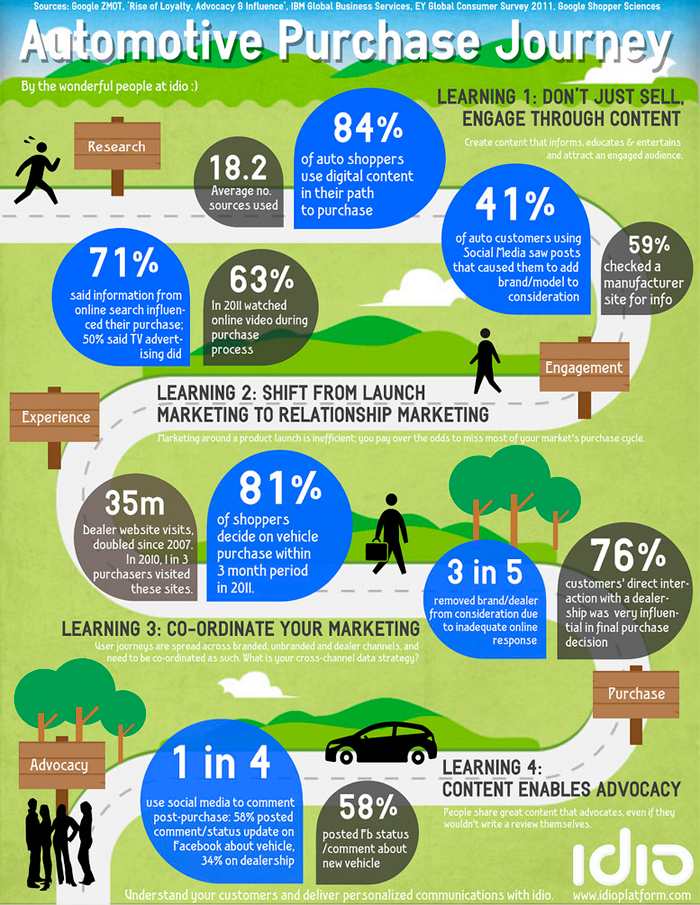
Image via Flickr, Digital Ralph
- Be Authentic. This means demonstrating and delivering on a brand’s values, credibility, and promise. Honesty is the strongest positioning for any brand. And without honesty, there cannot be confidence. Without confidence, there cannot be loyalty.
In a global survey, PR agency Cohn & Wolfe indicated 87 percent of consumers say it’s important for brands to “act with integrity at all times,”[3] reported AdWeek.
Watch the former CEO of Avis discuss the birth of the “We Try Harder” campaign.
The world’s #2 car rental company designed a classic underdog ad campaign in the 1960s, but Robert Townsend explains that without meeting brand promise for customers and sharing the brand culture with employees, the campaign would backfire and kill the brand forever.
As a brand evolves and grows, a brand health check ensures you keep your finger on the pulse because it enables you to keep track of potential strengths and weaknesses together with opportunities for innovation and growth — and when needed it identifies when a brand refresh is required before your brand hits a downward slope.
“Being honest, insightful, realistic, and open to change will enable you to develop and deliver an authentic brand that truly connects with internal and external audiences. Consider your brand a work in progress, even if you think you’ve got it figured out.”[4]
Ask Yourself These Questions:
- Does your brand have all its pillars in place and are its foundations strong?
- Does your brand embrace storytelling as part of its differentiation?
- Are you monitoring the life cycle of your brand itself, or just its visual identity?
- Has your team grasped the difference between branding and design?
- Are you aware of how your customers view your brand on authenticity and on delivering its promise? Is your brand fully aligned between internal and external perceptions?
- Are you delivering a strong, consistent message across all customer touchpoints?
[1] https://www.fastcodesign.com/3066401/the-best-and-worst-branding-of-2016
[2] https://9to5mac.com/2017/07/29/apple-top-retailer-per-square-foot
[3] http://www.adweek.com/digital/the-20-most-authentic-brands-in-the-us-and-why
[4] http://www.chiefmarketer.com/the-art-of-authenticity-in-branding

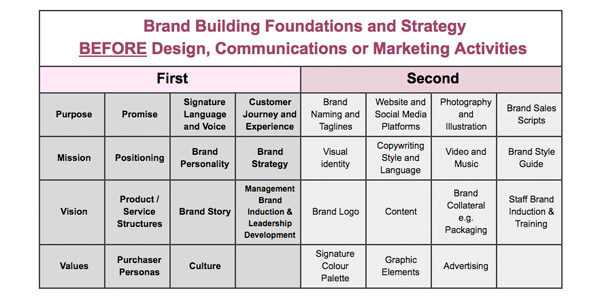



Leave a Reply
Want to join the discussion?Feel free to contribute!